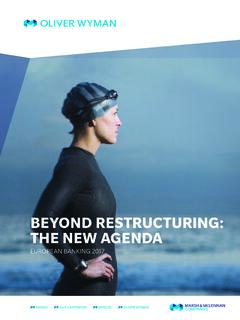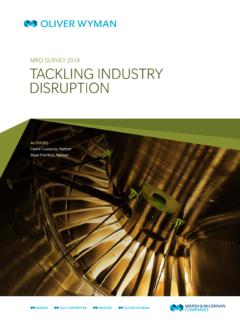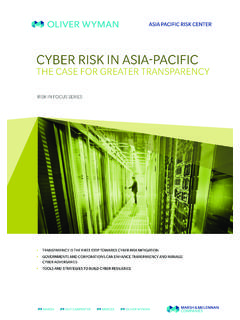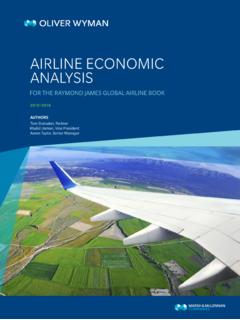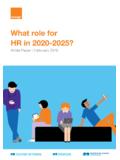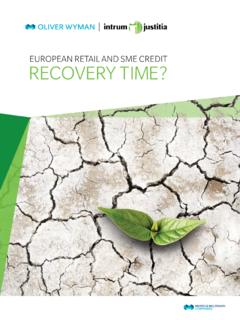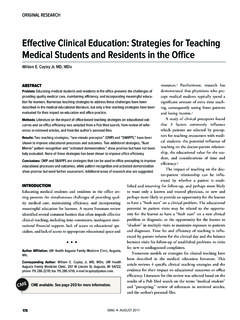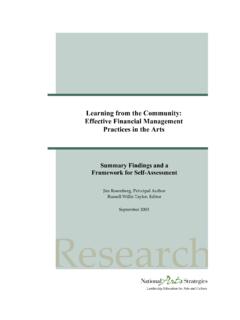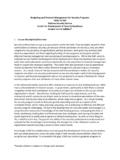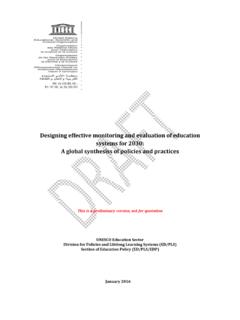Transcription of FINANCIAL RESOURCE MANAGEMENT - …
1 FINANCIAL RESOURCE MANAGEMENTBALANCING COMPLEX AND COMPETING CONSTRAINTS ON CAPITAL, LIQUIDITY AND FUNDINGAUTHORSIlya Khaykin, PartnerUgur Koyluoglu, PartnerDouglas Elliott, PartnerChristopher Spicer, PrincipalBASEL IIICAPITALRATIOSLIQUIDITYCOVERAGERATIOLE VERAGERATIOSSTRESSTESTS CCAR COLLATERALREQUIREMENTSTOTAL LOSSABSORBINGCAPACITYNET STABLEFUNDINGRATIOLARGEEXPOSURELIMITSCAP ITALBUFFERSLEGALENTITYREQUIREMENTSRISKAP PETITE/LIMITSCAPITALFLOORSECONOMICCAPITA LSTANDARDIZEDAPPROACHESFUNDAMENTALREVIEW OFTRADINGBOOKINTERESTRATE RISKIN BANKINGBOOKC opyright 2017 Oliver WymanTHE FINANCIAL RESOURCE MANAGEMENT PUZZLEWhat happened to ROE?EXECUTIVE SUMMARY 31 INTRODUCTION 62 CURRENT STATE OF FRM 83 KEY FRM CHALLENGES 154 THE WAY FORWARD CONCEPTUAL FRAMEWORK FOR FRM ORGANIZATIONAL MODEL 215 CLOSING THOUGHTS 25 TABLE OF CONTENTSC opyright 2017 Oliver Wyman 2 EXECUTIVE SUMMARYIn the second half of 2016, the International Association of Credit Portfolio Managers (IACPM) and Oliver Wyman jointly conducted a survey on FINANCIAL RESOURCE MANAGEMENT (FRM)
2 Practices with 48 leading banks around the world. This paper reflects the survey findings and follow-up conversations with a subset of surveyed institutions, along with our views on the way managing FINANCIAL resources has always been crucial to bank economics. Before the FINANCIAL crisis, the exercise was simpler: The universe of FINANCIAL constraints was more limited, and the consequences of any sub-optimal decisions were less severe; capital, and especially liquidity, was readily available and in retrospect, relatively the post-crisis environment, managing FINANCIAL resources has become exponentially more difficult for banks: A multitude of spot and scenario-based FINANCIAL constraints have been introduced; The commercial impact of these new constraints is complex and often not easily understood; Regulatory minimum ratios, rather than internally-defined metrics, are now virtually always the most binding factors on RESOURCE usage.
3 And Regulators have assigned different levels and definitions of FINANCIAL RESOURCE constraints across jurisdictions, creating interrelated and overlapping layers of constraints for global FINANCIAL institutionsHowever, getting the answer right on FRM is nonetheless essential to having an accurate view of a bank s best use of limited resources and a thorough understanding of both absolute and relative performance of banking activities and products, and in turn, to enabling overall bank SOLUTIONS, FITS AND STARTSW hile many banks have recognized the new challenges, progress on developing sustainable and holistic FRM has been limited in recent years. The IACPM/Oliver Wyman survey confirmed that there is still a wide range of FRM approaches being deployed in the new constraint environment, with no clear industry standard having yet emerged.
4 Moreover, while institutions have reported developments on framework, infrastructure, organization and commercial shifts, there is at least as much to do ahead for the industry as has been done 2017 Oliver Wyman 3To date, banks have adapted to the new exigencies for FRM through both conceptual and tactical solutions. Many institutions have altered their methodologies to reflect some of the new constraints; and there are numerous examples of banks reflecting the new FRM considerations in their business decisions via ad hoc, pragmatic approaches.
5 Despite the challenges in defining the new conceptual FRM framework, banks have already been making significant changes in their risk profiles and strategies that reflect the new constraints. These changes range from broad strategic actions such as moving and/or exiting certain businesses, products and/or geographies to tactical changes in pricing and MAIN CHALLENGES FOR FINANCIAL RESOURCE MANAGEMENT NOWThe obstacles to effective FRM in the post-crisis era are numerous and varied across , several recurring themes are apparent across the surveyed firms: Process coordination: Many different businesses and functional areas now need to be actively involved in FRM, and their involvement requires complex coordination rather than just bilateral interactions Conceptual framework: The conceptual framework for incorporating all of the new constraints into FRM processes has not yet been fully established at most firms Data and infrastructure.
6 The still evolving data infrastructure doesn t always allow FRM-related business decisions to be made in a timely manner, particularly at lower levels of granularity, such as for business- or client-level decisions Governance: Given that FRM has implications throughout the bank, governance and decision making present significant and broad-ranging challenges for FRM impacting coordination, institutional buy-in, and implementationTHOUGHTS ON THE WAY FORWARDIn managing FINANCIAL resources, banks make decisions across a range of tactical and strategic priorities as well as at all levels of the enterprise. Banks will need to link their FRM approaches to these business processes. Two components of effective FRM will be critical for addressing these business needs: Conceptual framework and operationalization: It is critical for banks to decide which of the multitude of constraints matter in managing FINANCIAL resources and how those constraints should be incorporated in the FRM framework.
7 The relevant constraints will be influenced by business model and geography, among other considerations. Approaches attempting to take multiple constraints into account will differ and there will not be a one-size-fits-all solution. Furthermore, the relevant metrics for FRM and their calibration will differ depending on both the business purpose and the time horizon for RESOURCE deployment, as binding constraints may evolve over time. Finally, many of the regulatory constraints are articulated over multiple types of FINANCIAL resources, which often have different cost structures; the different cost implications for different RESOURCE types also must be incorporated in the 2017 Oliver Wyman 4 Organizational model: Given the inter-related impacts of multiple contemporaneous FINANCIAL constraints, some of which may even be sending conflicting signals for decision making, it is imperative for banks to have a dedicated central coordinating function for FRM.
8 Core activities for this function would include defining a bank s FRM objectives and identifying trade-offs, coordinating the development of a holistic set of metrics to drive incentives toward those objectives, and providing enterprise-level perspectives for process optimization and content , FRM in the post-crisis era touches on the whole bank. Making changes to the conceptual framework and organizational model alone are not enough to establish strong FRM, but they are necessary steps. As the survey results indicate, there are many additional and significant challenges to be worked through, such as evolving the data environment and infrastructure to effectively support FRM in its requirements for timeliness and granularity of information. FRM should drive incentives and motivate good decision making throughout the firm focusing on people, education, transparency, and behavior is also critical.
9 Furthermore, the supervisory expectations are bound to evolve, in important ways. In addition to meeting minimum requirements on FINANCIAL RESOURCE levels, Supervisors will want to know that banks have a coherent, sensible, and firm-wide approach to FRM, and they will want to understand the implications of the particular approach for the business decisions the bank will make. For example, the sustainability of a firm s business model has become a key part of assessments by European regulators. Regulators recognize that one of the underlying causes of the FINANCIAL crisis were incentives to do the wrong business at the wrong price, driven in significant part by capital pricing and allocation and funds transfer pricing (FTP).Regardless of the exact evolution of banks and their regulation, successful FRM will require a comprehensive undertaking to transform the FRM framework to fully reflect the new FINANCIAL constraints and transmit those constraints in a consistent manner throughout the bank; and to adapt the organization to effectively support 2017 Oliver Wyman 51.
10 INTRODUCTIONE ffectively managing FINANCIAL resources has always been crucial to bank economics. Before the FINANCIAL crisis, the exercise was simpler: The universe of FINANCIAL constraints was more limited, and the consequences of any sub-optimal decisions were less severe; capital, and especially liquidity, was readily available and in retrospect, relatively cheap. Responses by regulators and markets to the lessons of the crisis have added much complexity. The new operational landscape of greater, more complex, and more stringent constraints requires a more comprehensive, tightly-coordinated approach to the answer right on FRM is essential to having an accurate view of a bank s best use of limited resources and a thorough understanding of both absolute and relative performance of banking activities and products, and in turn, to enabling overall bank success.
